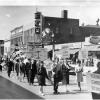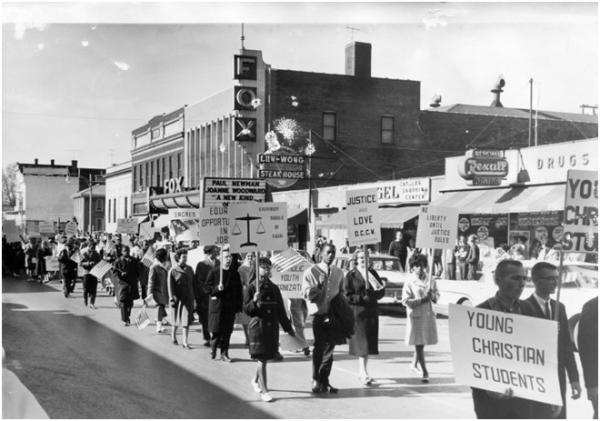Iowa's Role in Civil Rights
| Grade | 9th -12th Grades | Class | Social Studies | Length of Lesson | 50 minutes |
| Lesson Title | Iowa's Role in Civil Rights |
| Unit Title | Civil Rights in Iowa |
| Unit Compelling Question | Was the Civil Rights Movement significant in Iowa? |
| Historical Context: Fort Madison Protest: https://iowamuseums.pastperfectonline.com/webobject/E2898ED1-C94C-4662-A... This photograph shows a protest march that occurred in Fort Madison, Iowa in 1963. Freedom Summer Volunteers: https://iptv.pbslearningmedia.org/resource/freedomsummer_20160404_03/soc... In late 1963, organizers of the Freedom Summer began recruiting on college campuses for volunteers to help with voter registration efforts and community work in towns throughout racially segregated Mississippi. Students were motivated by the scenes playing out on the nightly news, in the press and by national authors who were bringing attention to civil rights issues. In this video segment from Iowans Return to Freedom Summer, Marcia Moore, Patti Miller, and Marvin Gatch recall their motivations for volunteering to travel to Mississippi in the summer of 1964. |
|
| Lesson Supporting Question | |
| Lesson Overview | |
| Primary Sources Used |
|
| Resources Needed | Computers, projector for videos https://iptv.pbslearningmedia.org/resource/freedomsummer_20160404_03/social-injustice-motivates-midwestern-freedom-summer-volunteers-iowans-return-to-freedom-summer/ https://iowamuseums.pastperfectonline.com/webobject/E2898ED1-C94C-4662-AB35-650530079737 |
| Standard | |
| Lesson Target | Students will be able to demonstrate their understanding of the Civil Rights Movement on a local and rational level.;Students will be able to analyze how historical events affected individuals living in Iowa during the time period. ;Students will connect to Iowans living during the time period and understand their perspectives and how some faced discrimination while others did not based on the color of their skin.;Students will be able to understand how Iowans influenced the history of the Civil Rights Movement in their state and country. |
| Lesson Themes | Civil Rights, African American Experience |
|
| Formative Assessment (How will you use the formative assessments to monitor and inform instruction?) |
The letter turned in at the end of class, which must fit the full criteria listed in (6) for full credit. |
| Summative Assessment (How does the lesson connect to planned summative assessment(s)?) |
Final paper or test on the unit. |
| Author | Natalie Berry, Dr. Heidi Lung | Created | Last Edited | ||||
| Reviewer: Dr. Heidi Lung, University of Iowa | |||||||
| Lesson Plan Development Notes: Museum Studies Program, The University of Iowa | |||||||


